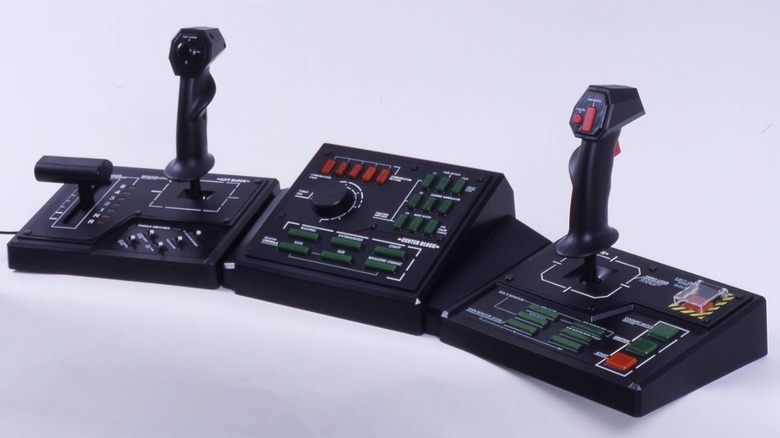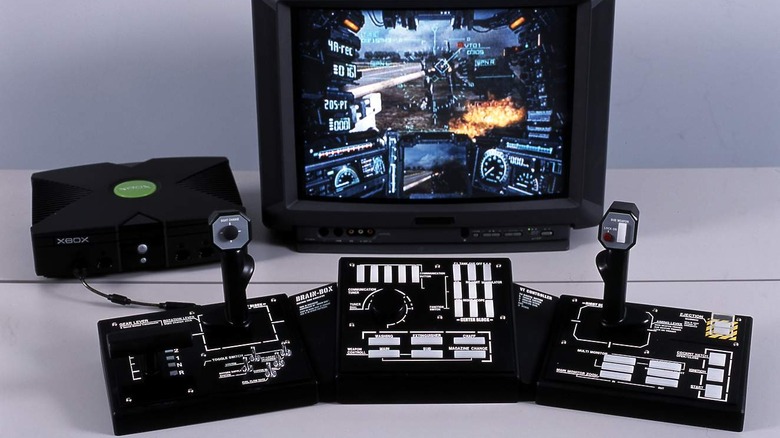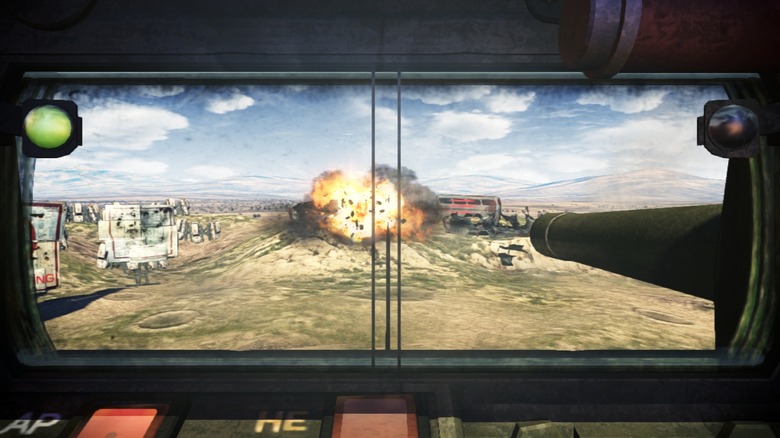The Untold Story Of The Most Insane Game Controller Ever Made
Hardware manufacturers have made lots of crazy video game controllers over the years. There's the Power Glove, the motion controller-turned-meme that you wore on your hand and that barely worked. There's the ridiculously detailed Resident Evil 4 Chainsaw Controller, which isn't ideal for playing games but makes for an excellent, if gory, decoration. There's the Novint Falcon, which was originally designed for complex science experiments, and the Dreamcast's oddly versatile fishing rod add-on, and whatever the heck this Wu-Tang Clan-inspired gamepad is supposed to be.
None of those will prepare you for Steel Battalion and its one-of-a-kind peripheral. Just look at that thing. It's needlessly complex. It's so massive that you need to assemble the device yourself. It's three feet long. It's ostentatious in all the best ways, crammed full of more features than you'd ever need, requires both hands and both feet to use properly, and only works (officially) with two games: Steel Battalion and its multiplayer sequel.
In other words, the device is gaming at both its very best and its very worst. Just wait until you see what this beauty can do. By any measure, Steel Battalion's controller is legitimately insane — and we can't help but love it. Hopefully, you will too.
But what is it, exactly?
Let's back up a little. If you weren't part of the gaming scene back in the early '00s, you might not know what Steel Battalion is all about — or, maybe you just forgot. After all, it's been a while.
In short, Steel Battalion is a 2002 video game in which players pilot giant "vertical tanks" (i.e., mechs) developed and published by Capcom with an assist from Nude Maker, a company founded by a number of former Human Corporation developers. Steel Battalion started out as a PlayStation 2 title, but switched to the OG Xbox console later in the development process. As producer Atsushi Inaba explained to CVG, Sony's console wasn't quite powerful enough to deliver the visual experience that Inaba and the rest of the team were gunning for. By contrast, the Xbox, which had more processing power, could get the job done.
Steel Battalion takes cues from series like MechWarrior and Armored Core, but it's decidedly its own thing. Thanks largely to that controller, Steel Battalion is the most immersive and complex mech simulator ever made — not to mention the most expensive. At launch, a copy of the game, controller included, cost $200. Financially, the game did okay, but not great. It broke even and got both a re-release (with a slightly modified controller) and a couple of sequels, but didn't exactly set the world on fire. That's to be expected. With a price tag that's bigger than some consoles', Steel Battalion was always going to be a niche product.
Controller first, game second
Capcom didn't set out to make a great mech game only to decide that it needed a gargantuan controller later. The hardware came first. At 2005's Game Developers Conference, Atsushi Inaba told panelists that Steel Battalion was a "a product-focused project." As Gamasutra (which is part of UDM, the company that runs GDC) summarizes, Steel Battalion "was all about creating a quality peripheral and appropriate software to go with it."
That's a big risk, but as Inaba says, the chance to make a controller that crazy was "a once in a lifetime opportunity," and that if Capcom didn't pounce when it could, Steel Battalion never would've happened. Besides, Steel Battalion's controller helped ensure that the game would stand out from the crowd, and managed to attract a fair amount of attention from non-gaming audiences. As Inaba told CVG, "The game should also appeal to those interested in robots or mechanical things, for example; or perhaps anyone interested in aeroplanes and cockpits." The game wasn't the selling point. The hardware was always the main focus.
Not that Steel Battalion was easy to make, of course. In addition to creating a complicated new peripheral, Inaba's team also had to learn the ins and outs of a new console, master a genre that the developers had no experience in, and figure out how to deal with the then-new frontier of online console gaming. As it turns out, that was a little too ambitious — Steel Battalion's multiplayer mode was scrapped during production — but the results speak for themselves. Even Shigeru Miyamoto, the genius who created Super Mario Bros., was a little jealous.
Breaking down the beast
The Steel Battalion controller is an impressive piece of hardware, but what does it actually contain? In short: pretty much everything.
This monstrosity comes with two full-sized joysticks, three foot-pedals, two levers, 40 buttons, and a whole lot of plastic. That's a lot to keep track of, but thankfully, breaking the controller into sections makes things a little easier to follow. The left block, which contains the gear shift, ignition buttons, and one of the joysticks is what you'll use to steer your mech. The right block contains the other joystick, which aims and fires your weapon, radar toggles, and cockpit controls. That's also where you'll find the all-important eject button, which is protected by a clear plastic shell to prevent you from exiting your VT accidentally.
The center block is devoted to communications options, including a dial to change frequencies, a set of buttons with mission-specific features, and some weapon-related controls (it's also where you'll find the switch for the windshield wipers — yes, Steel Battalion is that detailed). As far as the foot pedals are concerned, you've got your ignition and your brakes, plus a third one that makes your mech leap out of danger.
A hardcore game for hardcore players
If the controller didn't tip you off, Steel Battalion is not a game for the faint of heart. It's a game for serious and dedicated players. To start with, your VT handles like a piece of heavy machinery. Turn sharply while going too fast, and your mech will topple over. Fire your weapons too fast, and it'll overheat. Every time that you start up your VT you'll need to close the hatch, boot up the operating system, flip five different switches, and hit a start button before you can proceed.
Steel Battalion also asks players to pay attention to a lot of different stuff all at once. In addition to steering, shooting, and accomplishing mission objectives, you'll also need to keep an eye on your fuel and ammo reserves, give your comrades in arms orders via the radio, and manage your radar, and that's just the tip of the iceberg. It's a lot — Steel Battalion's user interface is notoriously cluttered, so Lord help you if you have a small TV. And, oh, by the way? There's no tutorial. Unless you've got the manual handy, you need to figure everything out as you go.
But wait! There's more. Steel Battalion implemented a permadeath system years before that became trendy. If your character dies, you lose your saved game. That's why the eject button is so important. Bail in time, and you get to keep your progress. Hang around too long, and all your hard work will go up in flames along with your fancy ride.
Your mileage may vary
Steel Battalion is complex, immersive, and requires a lot of attention, but that doesn't necessarily mean that it's good. Review-wise, Steel Battalion is all over the place.
Most critics seem to agree that, everything else aside, Steel Battalion's controller is a blast to use. GameSpy claimed that the add-on "turns an above-average game into a remarkable simulation," while IGN calls Steel Battalion "the most immersive mech simulation you can get" thanks to the gargantuan peripheral.
The rest of the game is a mixed bag. Everyone seems to like the sound effects, but some reviewers found the graphics bland and lacking, especially when compared to Steel Battalion's ultra-detailed hardware. Its learning curve is steep and its save-file-deleting mechanic frustrating and unforgiving. The artificial intelligence driving your allies is as dumb as rocks.
More crucially, once the controller's novelty wears off, many reviews claim that Steel Battalion is a shallow and repetitive experience. Eurogamer notes that the long boot sequence gets tedious quickly, and that once you figure out the controls, there's not much to keep you coming back for more. GameSpot calls Steel Battalion "a short, fairly simplistic game," and warns players in search of a deeper experience to stay away.
Basically, how much you'll like Steel Battalion comes down to how much you like that controller. If you dig it, you'll have a good time. If you get bored easily, expect Steel Battalion's hardware to join all those plastic guitars in your closet sooner rather than later.
More bang for more bucks
Back in 2002, one of the biggest knocks against Steel Battalion was that, for the amount of money and space that the game requires, it's not exactly a great value. $200 is a lot of money to pay for a controller, especially when that controller only works for a single game. Once you finished Steel Battalion, your faux control center seemed destined to sit in the corner, gathering dust.
As it turns out, that didn't end up being entirely true. Steel Battalion's controller actually works with two games — we just hope you like playing with others. Steel Battalion: Line of Contact premiered in 2004, and like its predecessor, requires the behemoth controller to run. Unlike the first Steel Battalion, Line of Contact is a multiplayer-only experience. By connecting to other Xbox consoles via a local area network or by hooking up online, Line of Contact lets would-be mech pilots team up for a player versus player campaign or battle it out in deathmatch and capture-the-flag inspired modes.
Line of Contact doesn't change much as far as the graphics or gameplay is concerned, and some critics balked at forking out another $50 (plus Xbox Live fees) for what's basically a multiplayer expansion. Given that the first Steel Battalion had a relatively small audience, and that you need that controller to play, Line of Contact's multiplayer servers weren't exactly bustling, either. Given those concerns, however, critics seemed to like the game. Game Informer called it "an unparalleled video game experience," while Game Spy christened Line of Contact "the most engaging experience you can have with Xbox Live." You just had to pay to enjoy it.
Steel Battalion ain't nothin' without its gear
As you've seen, Steel Battalion is all about the hardware. So, what happens when you take that beefy controller away? It's simple: you kill the entire franchise dead.
Capcom learned that the hard way in 2012, when it released Steel Battalion: Heavy Armor for the Xbox 360. Instead of utilizing Steel Battalion's signature controller, the game used a combination of the Xbox 360 gamepad and Microsoft's unique motion-sensing tech, the Kinect. Producer Kenji Kataoka told Digital Spy that, even with 40 buttons, Steel Battalion "was limited by the controller." By using motion controls, Steel Battalion: Heavy Armor "opened the door to pretty much infinite possibilities" control-wise. Unlike most Kinect games, Heavy Armor wasn't supposed to be a casual-friendly title, either. Capcom brought in FromSoftware — y'know, the guys who made the ultra-hardcore Dark Souls — to help with development.
That could've been great, if the game had worked. It didn't. Outlets like EGM and Eurogamer panned Heavy Armor, claiming that the motion controls simply didn't register consistently or correctly, making Heavy Armor nearly impossible to play. Even the Official Xbox Magazine, which gave Heavy Armor its only positive review, admitted that Kinect introduced a considerable "potential for error." The damage was done. Heavy Armor flopped, and over half a decade later, Steel Battalion is nowhere to be seen.
Is it a controller, or is it art?
While Steel Battalion might be out of commission for the foreseeable future, the game and its legendary controller live on thanks to fans and hardware enthusiasts. Despite its size and lack of versatility, the Steel Battalion rig has become a relatively popular collector's item that still sells for around $200. In 2010, a group of Steel Battalion enthusiasts raised funds to bring ten OG Xbox consoles and Steel Battalion set-ups to the Penny Arcade Expo, where many curious onlookers got their hands on the controller for the very first time.
Others have found new and interesting uses for Steel Battalion's hardware. David Shuff transformed the controller into a full-on art installation called the Big Steel Battalion Box, which debuted in Brooklyn, New York in 2004. When using the B.S.B.B. Mk. II, players sit in a custom-made pod that features extra lights and vibrational feedback, while an coach gives them directions via headset, walking them through the game using a simplified manual. It's not just a cool way to play Steel Battalion. Shuff says that the bond between player and coach creates unique feelings of "emotional sensations of reliance, trust, and bonding."
It goes on. In Japan, a VJ known as Bonsajo converted the controller into a makeshift control deck that cues lights and distorts videos. Someone else converted it into a MIDI controller, transforming the device into a musical instrument. Obviously, it's big for gaming, too. Thanks to fan-made PC drivers, the controller is a popular add-on for high-end space simulators like Star Citizen, Elite: Dangerous, and Kerbal Space Program.
Gone but not forgotten
If Steel Battalion proved anything, it's that a good accessory — even an ostentatious and ridiculous one — can add a lot to a game. As such, it's hardly a surprise that many, many titles have followed in Steel Battalion's footsteps, especially ones that feature mech on mech combat.
When Hawken, a free-to-play mech-based shooter, got an E3 demo in 2012, it debuted with a special controller called the MEK-FU, and if it looks familiar to you, you're not alone. Many observers called out the MEK-FU's similarity to Steel Battalion's massive controller, although manufacturer RIPLEIGH's offering did have a couple of differences: it would've been easier to store, and worked with games other than Hawken, giving you a little more value for your money (though, sadly, the controller never materialized, and one forum-user called it "vaporware"). That same year, Razer unveiled the Artemis prototype, a desk-consuming monstrosity designed for MechWarrior Online. Starting to see a trend yet?
It's not just mech games, either. The Wii U's tablet-like gamepad reminded Swedish developer Nicklas "Nifflas" Nygren of Steel Battalion, and directly inspired Affordable Space Adventures, which Nygren made alongside KnapNok Games.
Will we ever see another controller as gloriously insane as Steel Battalion's? Probably not. The controller ultimately limited the potential size of Steel Battalion's audience. It was too big, too hard to use, and too expensive. But even if Steel Battalion is over, its spirit lives on — and we wouldn't have it any other way.



